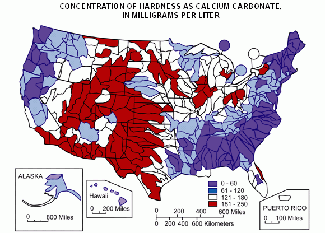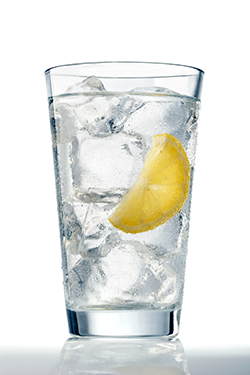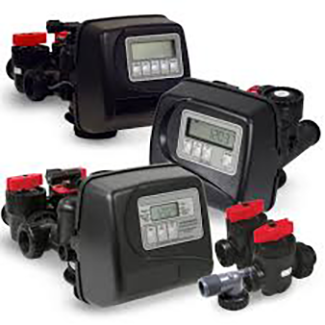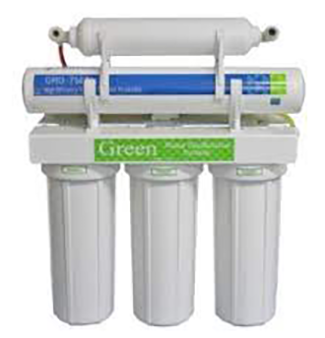Improve The Quality And Taste Of Drinking Water With Reverse Osmosis
Improve The Quality And Taste Of Drinking Water With Reverse Osmosis
In some parts of Arizona, you need a fork and knife to drink the water coming from the taps. We have among the highest mineral content in the United States. According to a recent U.S. Geological Survey, 85 percent of the United States geography has hard water.

That means our water contains naturally dissolved minerals like calcium and magnesium. Excessive minerals in the water create rust stains, clog pipes, and affect water's taste.
The USGS explains that hardness is caused by compounds of calcium and magnesium, and by a variety of other metals. General guidelines for classification of waters are 0 to 60 mg/L (milligrams per liter) as calcium carbonate is classified as soft; 61 to 120 mg/L as moderately hard; 121 to 180 mg/L as hard; and more than 180 mg/L as very hard.
The "hardness" of your water depends on how many grains of the minerals it contains per gallon. This is called grains per gallon, or GPG. The water is drinkable.
Water that contains more than 1 GPG is considered somewhat "hard"; water with more than 10.5 GPG is very hard. A typical glass of Arizona water has at least 15 GPG!
An Option For Improving Your Drinking Water

Reverse Osmosis, sometimes referred to as RO, is primarily a point-of-use water purification system that improves both the quality and taste of drinking water. Most of our customers choose an under-sink installation with connection to a bar faucet, making it simple to use RO water only for consumption,” says George Cathey, Service Manager at Rosie-Certified, Isley’s Home Service, Inc.
A reverse osmosis system can also be connected to your refrigerator’s water and ice dispensers.
Reverse osmosis removes a wide variety of particles from your water, including arsenic, aluminum, chloride, chlorine, iron, lead, and mercury. It may also remove pesticide residue.
Note: RO systems are not water softeners. In residential applications, they are generally installed for the sole purpose of providing clean, great-tasting drinking water. These drinking water systems are small and typically installed under the kitchen sink. Softeners are for Whole House Filtration.
How does reverse osmosis work?
In most units, the water goes through two filters and a membrane. The first is a 1- or 5-micron filter that removes larger particles like rust, silt, and sediment. The second filter is a carbon filter, which helps remove high chlorine levels that are typically found in much of Arizona’s water.
“When you turn the water on at the RO faucet or dispense water through a refrigerator that's attached to the RO system, the refined water passes through this second filter to remove unpleasant tastes and odors. The water travels through the filter to a membrane, which is the operational center of the RO. Hydrogen and oxygen pass through the membrane's microscopic pores, flush dissolved minerals down the drain, and refined water fills the storage tank,” explains Cathey.
Does reverse osmosis remove fluoride from the water?
 Yes, it typically does. According to the Fluoride Action Network, about 58 percent of Arizona municipalities practice what’s known as community water fluoridation, which adds fluoride to water to improve dental health and reduce tooth decay. Fluoride naturally occurs in minerals and is carried into our homes through groundwater. If you are concerned about fluoride levels in your home, Cathey suggests you contact your local Arizona water utility.
Yes, it typically does. According to the Fluoride Action Network, about 58 percent of Arizona municipalities practice what’s known as community water fluoridation, which adds fluoride to water to improve dental health and reduce tooth decay. Fluoride naturally occurs in minerals and is carried into our homes through groundwater. If you are concerned about fluoride levels in your home, Cathey suggests you contact your local Arizona water utility.
How much does a reverse osmosis system cost?
“The price for Isley’s Home Service’s RO systems ranges from $500 to $600 installed,” says Cathey. “We carry the Ultima 7 RO unit, which is manufactured in Gilbert by B&R Industries. Because the Ultima is manufactured locally, replacement parts and filters are easy to get.”
1 | Benefits of RO systems
- Save money on bottled water.
- Convenience of not having to buy bottled water or have it delivered.
- Cleaner and healthier than tap water.
- Food and beverages taste better when made with RO water.
- Clearer, better-tasting ice.
2 | Benefits of Water Softener
- Skin feels softer and moisturized after showers.
- Hair is softer after showers.
 The lifespan of water-using appliances and fixtures increases.
The lifespan of water-using appliances and fixtures increases. - Clothes remain cleaner and brighter.
- Reduces or eliminates scale buildup on fixtures.
- You will use less soap and detergent, thus saving money.
3 | Alternatives to Water Softeners
Isley’s offers all of the options listed below. “Customers are more educated in water conditioning because of the internet. A lot of customers know what they want before we arrive to give a quote,” said Cathey. “Some absolutely do not want water softeners. Some want water softeners that do more. It all depends on what the customer’s individual needs are. We always make an effort to make sure the customer knows what they are buying, what the system can and can't do, maintenance requirements, and the pros and cons of each system. The vast majority, probably 80 to 90 percent, end up buying a softener.”
- Whole House Carbon Filter | Reduces chlorine and odors, so water smells and tastes better.
- Scale Inhibitors | Reduces scale buildup on fixtures yet are not "true" water softeners. Meaning the process that is used to remove the hard minerals is different. By definition, water softeners use a process called “ion exchange” to soften the water. Scale inhibitors use “catalytic conversion” to reduce scale buildup. If you were to test the water from a scale inhibitor, you will see that the hard minerals are still present. The minerals have been altered as to not “attach” to fixtures. But water softeners actually remove hard minerals.
- Sediment Filters | Removes rust and particulates.
- Carbon Filter / Water Softener Combo | Combines the benefits of carbon filters and water softeners into one system.
- KDF Filters | Removes heavy metals, chemicals, bacteria, and fungus.
NOTE: These water softener alternatives are not intended to produce the same results as a water softener. They have very different intended purposes. Although it is possible to soften water with large RO systems, they take up a lot of space and are not cost-effective, ranging in the tens of thousands of dollars. The systems mentioned above range from $1,500 to $2,000. Contact Isley’s for pricing.
As noted in Rosie's Water Treatment Consumer Guide:
The position of the Arizona Water Quality Association (AZWQA.org) is that most alternative conditioner firms do not offer independent confirmation that they can remove calcium or magnesium ions from water or reduce the scale formation caused by hard water. On the contrary, many studies of these devices, particularly magnetic and catalytic units, report that no scale reduction takes place.
As part of their presentation, some alternative treatment companies also offer carbon filtration, which they claim will purify water as well. Carbon filters are not permanent devices and must be replaced periodically to avoid bacteria growth. The same is true for in-line carbon filters in refrigerator water units.

Cathey notes a filter media called Filtersorb. It does not change the hardness of the water. Small, specially treated polymer spheres convert dissolved hardness into microscopic crystals. Once the crystals grow to a specific size, they are released from the bead. He says it is a scale inhibitor with third-party studies proving its effectiveness. Filtersorb is the only scale inhibitor Isley’s will install and only after educating the customer on why a softener would be better. Yet, in his experience, some people insist on a salt-free system, which can be a good alternative for customers who cannot physically handle the heavy bags of salt.
4 | New Products
- RO Systems and Water Softeners now have "green" options that use less salt and water. Green Softeners use 50 percent less salt and water than conventional softeners. An RO system produces less wastewater. A normal RO wastes three to five gallons for every one gallon of drinking water. A green RO wastes one gallon for every drinkable gallon.
- Green Fusion Water Softener- Combines green softener, carbon filters, and KDF filters into one unit.
There are many water treatment options available based on needs and budget. Explore all of them before making a final decision.
Home Maintenance To-Do: #BetterWater
Podcast
You can improve on Arizona's hard water and instead have better tasting, mineral free water. George Cathey of Isley's Home Service explains how this is possible with an R/O system and whole house soft water treatment. Most Asked Question This Week has to do with home warranties: Rosie explains how they work, why we don't recommend them and an alternative you already have for your home.
Sponsored By: Isley's Home Service
 Located in Gilbert, AZ and serving the Greater Phoenix area since 1957 is Isley's Home Service, Inc. They offer a variety of services including options for softening the water in your Arizona home, point-of-use reverse osmosis systems, and whole-house water filtration systems. Isley's Home Service also offers an annual maintenance plan as mentioned above for your existing reverse osmosis and water softeners. Never fear! Isley's is available 24/7 for emergency repairs.
Located in Gilbert, AZ and serving the Greater Phoenix area since 1957 is Isley's Home Service, Inc. They offer a variety of services including options for softening the water in your Arizona home, point-of-use reverse osmosis systems, and whole-house water filtration systems. Isley's Home Service also offers an annual maintenance plan as mentioned above for your existing reverse osmosis and water softeners. Never fear! Isley's is available 24/7 for emergency repairs.
###
Photo Credits:
- Isley's Home Service, Inc.
- USGS.gov
- Shutterstock
- iStock
RELATED CONTENT:
- AZWQA: Water Softener Sustainability Professional | Arizona
- Arizona Water Quality Association: AZWQA.org
- Environmental Working Group’s What’s In Your Water Program
- Blog: Water Treatment Softening Myths
- Blog: Water Treatment From A One-Time Skeptic
- DIY Q&A: Rosie's Water Treatment Consumer Guide
- DIY Q&A: Would My Home Benefit from a Water Treatment System?
- DIY Q&A: What Is Hard Water?
- DIY Q&A: Clean Water For Your Home
- Podcast: Plumbing Maintenance, Water Saving And Gas Fitting Appliances
